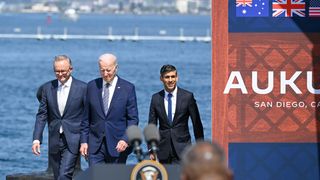The AUKUS report is one of the most significant defence pacts in Australian history, and experts at the United States Studies Centre have provided their take on today's important announcement.
AUKUS is a big play on the global chessboard
Dr Michael Green, United States Studies Centre CEO, and former White House National Security Council Special Assistant to the President for National Security Affairs and Senior Director for Asia
"USSC experts have been tracking AUKUS developments from the beginning. The quick reactions below reflect ongoing research projects at the USSC that examine everything from geopolitics to technology development, financing and sovereignty.
The operational case for nuclear-powered submarines is clear — this capability will allow the Royal Australian Navy (RAN) to maintain an undetected forward picket line that prevents adversaries from dominating the maritime approaches to the Australian homeland. Diesel subs would never have had the speed, distance or long-term undersea dwell time to do that. For decades the United States Navy and Air Force were able to keep foes at bay, but the maritime domain is now contested in the Western Pacific. Australia needs this sovereign capability and the United States has a clear interest in helping. That consensus is bipartisan in all three countries.
The biggest critique of AUKUS was that it would take too long. There is no fast way to create a sovereign capability in Australia for nuclear-powered attack submarines — but the AUKUS plan announced in San Diego does allow the deployment of capabilities in steadily increasing stages within just a few years. In the near-term deterrence will be enhanced by the rotation of US and UK subs to Western Australia, which will also allow Australia to begin building the infrastructure and support the RAN will eventually need. Autonomous undersea vehicles will also augment the Collins Class diesel submarines in the near term. The provision of 3-5 Virginia Class submarines by the early 2030s will then put powerful boats in the water on a faster timeline than expected. Over the medium-to-longer term the UK-designed boat will give Australia opportunities to develop a platform that has the best of US and UK technology but is designed to fit Australian requirements (including the need for smaller crew sizes than the giant Virginia class-subs).
The biggest critique of AUKUS was that it would take too long. There is no fast way to create a sovereign capability in Australia for nuclear-powered attack submarines — but the AUKUS plan announced in San Diego does allow the deployment of capabilities in steadily increasing stages within just a few years.
The debates about sovereignty addressed by Dr Peter Lee below are critical for Australians. Peter answers many of the criticisms. One other charge is that Australia will lose sovereign control because the nuclear propulsion systems will be American or British. The reality is that the Royal Australian Air Force (RAAF) also depends entirely on jet engines produced by the United States or the UK. Even the United States military now depends on others, as the name 'joint strike fighter' implies.
As Hayley Channer notes, the cost of the submarine program will require some other big choices. There is likely to be a trade-off between indigenous production and cost, for example. Generally speaking, the larger the share of work at home, the higher the cost. But there is another dimension: the longer the lifetime of Australia’s submarine program, the better the cost-benefit calculation associated with investing in production infrastructure and workforce. Implicit in the AUKUS decision is the likelihood that undersea warfare will remain a critical mission for Australian (and American and British) forces for generations. Then there is the question of overall spending on defence. Australia spends about two per cent of GDP on defence and the U.S. about 3.5 per cent. Japan, by comparison, is moving from just over one per cent of GDP to two per cent of GDP spending on defence over the next five years because of the same threat environment that motivated AUKUS. When it comes to the budget, other friends and allies of Australia are concluding that this is not a time for business as usual.
The submarine plan is also one part of a larger system of defence technology and industry innovations coming out of Australia. The submarines are covered under Pillar One of AUKUS, but Pillar Two – which covers collaboration on advanced technologies such as quantum and hypersonics — will be no less important. The Australian Government’s Guided Weapons and Explosive Ordnance (GWEO) Enterprise will also get a boost as the defence and technology base in Australia expands and the United States works through the technology transfer issues Tom Corben describes below. While Japan or Korea will not likely become part of the submarine program, these hi-tech allies of the United States could well 'dock' into Pillar Two of AUKUS or GWEO down the road. That is an appealing way to share innovation, cost and markets to the mutual security of all. But it is also complicated bureaucratically and will require reforms in tech transfer, security of information, and a host of other issues that Tom flags.
All three of the AUKUS partners would greatly prefer an Indo-Pacific region where economic cooperation defined international relations. There has been no mention of China by name, but the reality is that China’s militarisation of the East and South China Seas and attempts to do the same in the Pacific Islands necessitate major moves to reinforce deterrence and discourage the resolution of foreign policy problems by force. Beijing is not pleased with the announcement from San Diego, but the best way to begin bending regional dynamics back towards cooperation is to ensure that there will be no benefit from conflict or coercion."
AUKUS is one of the most ambitious defence capability pacts in history
Professor Peter J. Dean, USSC Director of Foreign Policy and Defence and a principal author of Australia's Defence Strategic Review
"This is one of the most ambitious defence capability pacts in history. The ‘optimal pathway’ charts out a clear direction for Australia to develop a nuclear-powered submarine capability: a critical capability to support Australian security, maintain the regional military balance and improve cooperation and security between all three countries.
The decision for the development of a trilateral design and build of a new class of submarine, SSN AUKUS, by the United Kingdom and Australia using the most advanced US technology will ensure that all three countries maintain a capability edge in undersea warfare and improve interoperability and put them on a path to interchangeability.
The decision by the United States to sell three, and possibly five, Virginia class submarines to Australia is a massive commitment by the US to supporting one of its key allies.
The decision by the United States to sell three, and possibly five, Virginia class submarines to Australia is a massive commitment by the United States to supporting one of its key allies. We should not underestimate the enormity of this decision given their own demands for these platforms.
This announcement does though raise risks and leave a lot of work to be done. The US Congress will have to approve the sale of the Virginia class to Australia. Billions are required in each country to increase infrastructure. Thousands of jobs will be created yet all three countries are struggling with workforce demands. In addition, the future of the Collins class and its longevity is still in play and major decisions on this capability and the future new SSN AUKUS class of boats still need to be made.
With the optimal pathway announced we are now at the end of the beginning, but we are still decades away from the beginning of the end. Lots could go right, and lots could go wrong over the next 30 years. Ultimately though this is a major decision to help ensure peace and prosperity in the Indo-Pacific."
The cost of AUKUS requires hard decisions
Hayley Channer, USSC Director of Economic Security
"AUKUS’ price tag — somewhere between $268-$368 billion over 30 years — is hard to fathom and hard to justify for external observers. With the shift from acquiring conventional submarines to nuclear-powered submarines, AUKUS was anticipated to cost significantly more, but the updated figures are still shocking.
Given Australia has a small to medium-sized Defence Force, investing seven per cent of the entire Defence budget towards one capability alone raises the question of opportunity costs across the whole Defence portfolio, as well as broader national trade-offs.
Undeniably, Australia needs to increase its defence spending. War in Europe coupled with great power rivalry and territorial disputes in our own region have created the conditions for Australia to invest further in defence. However, given Australia has a small to medium-sized Defence Force, investing seven per cent of the entire Defence budget towards one capability alone raises the question of opportunity costs across the whole Defence portfolio, as well as broader national trade-offs. Other defence capabilities will need to be delayed or cancelled, other national priorities will need to be re-evaluated, and there is the possibility of needing to borrow and higher taxes.
The $268 - $368 billion figure is comprehensive: It not only includes the cost of acquiring US Virginia-class nuclear submarines and Australia-UK co-design of an ‘AUKUS’ specific submarine but also the costs of upgrading Australia’s naval infrastructure and workforce education and training. Improving Australia’s maritime bases and shipbuilding capacity, plus a higher-skilled workforce and job creation, will have economic benefits. However, from an economic standpoint, purchasing submarines directly off US or UK production lines and investing the savings – potentially $100 billion or more – into Australia’s defence technology and innovation more broadly could have more far-reaching workforce and industry payoffs."
AUKUS guarantees Australia’s sovereignty, but on a costly and distant timeline
Dr Peter K. Lee, USSC Foreign Policy and Defence Research Fellow and an expert on middle powers and North-East Asian security
"In answer to legitimate concerns that AUKUS could make Australia unacceptably dependent on the United States and the United Kingdom as it acquires nuclear-powered submarines, the newly announced pathway offers clearer guarantees about how Australia will protect its national sovereignty.
First, the bipartisan Australian policy of not hosting foreign bases will remain unchanged. Instead, much like the annual rotation of US Marines through Darwin during the dry season, a rotational presence of US and UK nuclear-powered submarines will be hosted in Perth from 2027 and at a future east coast submarine base. On top of existing visits to Australia for training and exercises by US and other partner navies,’ these rotations will regularise and formalise that cooperation while rapidly upskilling Australia’s submarine workforce.
The US decision to sell Australia up to five of its Virginia-class submarines, subject to Congressional approval, will give Australia sovereign control over a game-changing capability.
Second, the US decision to sell Australia up to five of its Virginia-class submarines, subject to Congressional approval, will give Australia sovereign control over a game-changing capability. The significance of the US commitment evident in this decision cannot be understated. If achieved, Australia will be able to field nuclear-powered submarines faster than even the cancelled French submarine program. Finding and training the Australians to independently operate these massive vessels – 135 people inside a cylinder bigger than two Olympic-sized swimming pools – is the priority for this decade.
Third, the previous government’s promise that the submarines will be built in Australia has been kept, with the commitment that ‘SSN-AUKUS’ submarines will be simultaneously constructed in Australia and the United Kingdom. As Prime Minister Albanese repeatedly emphasised, a sovereign shipbuilding industry will be transformative, creating 20,000 jobs and fostering inter-generational skills and expertise. Moving to a continuous build footing here will further allow Australia to eventually support US and UK needs in the coming decades, adding to rather than detracting from their fleets.
Beyond sovereignty considerations, questions about this endeavour nonetheless remain. The opportunity cost of this endeavour for other national priorities or defence capabilities must be answered. The burdens of juggling three types of submarines next decade will be daunting. It is also unclear whether the government’s target of a fully operational force of eight SSN-AUKUS boats by 2053 will be sufficient to meet our needs if other countries start accelerating their shipbuilding programs. Finally, it is unclear whether future generations of Australians, not to mention the American and British public, will stay the course in the decades to come and pay the cost of this effort."
Building a safer future requires big thinking, and big spending
Blake Herzinger, USSC Foreign Policy and Defence Research Fellow and a former adviser to the US Pacific Fleet
"While the dates and costs will draw a lot of attention, the real stand-out in today’s AUKUS releases is the focus on the defence industrial base of all three countries, which are sorely in need of recapitalisation and expansion. This was the most serious potential obstacle to the success of this tripartite submarine project and it appears to be well-addressed in the plans.
While the dates and costs will draw a lot of attention, the real stand-out in today’s AUKUS releases is the focus on the defence industrial base of all three countries, which are sorely in need of recapitalisation and expansion.
In the near term, Australia will contribute billions to improving shipyard capacity in both the United States and the United Kingdom, where shipbuilding has slowed and atrophied since the end of the Cold War. This will enable those shipyards to hire and train new workers, expanding their ability to deliver on the ambitious goals set out by the AUKUS leaders both in terms of accelerating production of the Virginia-class as well as the development of SSN AUKUS. The United States also committed to several billion, with the promise of seeking several more, to this undertaking. This infusion of cash should be used to modernise creaking dry docks and public shipyards, the latter of which pre-date the Second World War. Revitalised shipyards will not only create jobs – a bipartisan win for all three nations – but create wartime resilience as well by buttressing the partners’ capability to repair damaged vessels. The synergy created by platform commonalities enables all three partners to jointly maintain and supply their forces as well.
From the beginning, many have expressed doubts about the likelihood of AUKUS achieving the grand goals set out for it – and they are admittedly grand. But as the United States, the United Kingdom, and Australia view the present state of affairs in the Indo-Pacific it seems clear that only big thinking and accordingly big investments will be enough to guarantee a peaceful future, or at least the ability to weather a less peaceful one."
Today's AUKUS announcement requires deeper defence integration
Tom Corben, USSC Foreign Policy and Defence Research Fellow and an expert on Japanese and Korean foreign policy
"Based on today’s announcement, the AUKUS optimal pathway (herein ‘the pathway’) should drive deeper defence integration between Australia, the United Kingdom, and the United States along at least four key pathways.
Platform interoperability: Greater familiarity with one another’s most advanced naval platforms will support what Defence Minister Richard Marles has referred to as a movement “from interoperability to interchangeability.” Rotations of US and UK submarines through HMAS Stirling as part of Submarine Rotational Force-West will help Australia develop its own operational capabilities and skills and, though not an explicit pathway objective, enhance the interchangeability of Australian, UK and US personnel and weaponry between each other’s vessels.
More frequent visits and rotations of US and UK submarines through Australian facilities immediately place a higher premium on bringing the joint logistics, maintenance, and sustainment components of the force posture initiatives to the fore.
Force posture: The pathway makes clear the quiet synergy between the AUKUS partnership and the US-Australia Expanded Force Posture Initiatives. More frequent visits and rotations of US and UK submarines through Australian facilities immediately place a higher premium on bringing the joint logistics, maintenance, and sustainment components of the force posture initiatives to the fore. Sustaining much higher operational tempos for a greater number of submarines, from all three countries, operating from Australian facilities will depend on this.
Industrial cooperation: Ensuring the timely delivery and effective operation of Australia’s submarines will depend on joint efforts to strengthen the three countries’ industrial bases. Embedding Australian workers alongside their American and British counterparts should foster the development of a shared skills and knowledge base between them. Investments in one another’s shipbuilding capabilities will also pay dividends for the financial health and sustainability of each country’s wider defence industrial ecosystem, and provide surge capacity for submarine construction, maintenance and repair.
Technology sharing: Greater technology sharing will be critical to the pathway’s success, especially if the AUKUS-class is to “leverage the best of submarine technology from all three nations.” US export controls have, historically, obstructed efforts to deepen defence industrial integration and technology sharing between the three countries, including through the US National Technology and Industrial Base. Reforms here will be critical to delivering 'best-in-class' Australian submarines on schedule."











